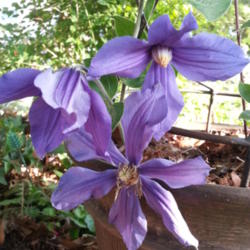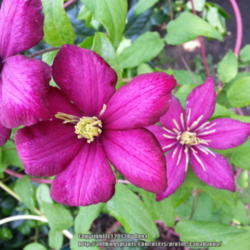It would seem that clems would not fit into my gardening style of naturalized settings with easy-care adapted and native plants. The fact that I can grow them should encourage you if you want to try them. My experience is in a warm southern climate, so the bloom times are generally better in the spring and fall.
My fascination began about 10 years ago when a neighbor told me she was going to plant clematis all along her wrought iron fence. I had thought that clematises only grew in the northern US and Canada, where I saw them seemingly growing wild. When I found a Clematis jackmanii at a local nursery, the sentimental and homesick side of me needed to try it. I only knew that the roots like to stay cool, so I dug a hole, added compost, put some broken pots in front of it, and watered it like mad! It bloomed! Luckily for me, I started with an easy one! Since then, I have realized that if the vines are planted properly, I can water them on the same schedule as my other plants.
The second clematis I bought was
Belle of Woking. I thought about digging it up because it would send up only one anemic vine every year. I got a lot of gorgeous blooms after I fertilized it, however. I was on a steep learning curve, as you see!
I learned that there were many more types than "the purple one" and became feverish about mail order and co-ops. Clematis collectors always wish they could have more sunny area and room for arbors. Thanks to all my online "clemmie friends", I received a lot of inspiration and tips.
Classifications for pruning:
Pruning classifications can be confusing. I'm not sure I can really understand all of the aspects without a horticultural degree. The pruning categories are pruning types 1, 2, and 3. Type 2 clematises are the "light prune" category. Type 3 are to be heavy-pruned and type 1 need no pruning.
I don't get too worried about the pruning groups. I cut all of my type 2 and 3 clematises back in February to one foot or less. If I just light-pruned a type 2, I probably would get earlier blooms. Zones with short growing seasons use this strategy.
A good general pruning rule is to cut back a new clematis to 1 foot in the first year or two to send the energy to the roots
Any Clematis viticella is also easier to grow than the other varieties. Generally, they are small flowered but have many blooms.
I often cut these down to one foot in July. (My summer is like the equivalent of winter in Texas!)
There is a group of non-vining clematis called
Integrifolia, which is one of my favorite groups.
Inspiration growing through prostrate rosemary.
Planting Clematis:
Dig a hole 18 x18, or bigger if you are able. Sprinkle bone meal at the bottom and mix soil with about 50% compost and expanded shale. Some people like to add moisture beads, but I haven't tried it.
Sink the plant's stem so it is 2-5 “ below soil level and lay it at a 45-degree angle in the direction you want it to grow.
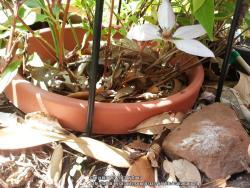
The roots like to be cool. Mulch well. I like to put a ring of rocks or 4” collar top of a pot to ID the area of the roots or at least some pecan mulch that Is different than surrounding mulch. Sedum is another good cover
I fertilize with compost tea, but rose food can also be used. I usually end up fertilizing twice a year, but once a month would be better. Try not to fertilize when there are buds or flowers because it makes the flowers bloom for a shorter time. A weak solution of epsom salts is good to encourage growth as well.
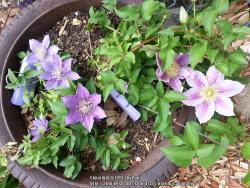
I have some shorter varieties as well as non-vining clematises in pots. I recently repotted
Bijou with some vermiculite. So far so good.
Supports for Clematis:
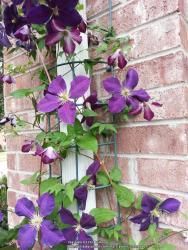 Walenburg
Walenburg and
Jackmanii on a downspout trellis. First year they are blooming together!
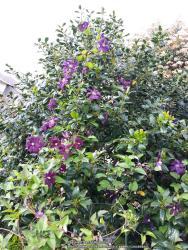 C. viticella 'Venosa Violacea'
C. viticella 'Venosa Violacea' growing into a holly.
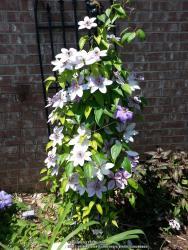 Nelly Moser
Nelly Moser outgrowing the obelisk.
Roses and Clematis are a classic combination too.
Clematises are tougher than you think. If you accidentally whack off the vine, you have not killed your plant. If you don't see any growth, it is probably best to wait a couple of years before you dig it up -- unless there is poor drainage, in which case you should dig it up! Otherwise, some TLC of epsom salts and compost will help. When you are planting combinations, keep the pruning type, growth habit, color, shape, and size in mind.
Patience is a virtue when it comes to clematis. Whether it is waiting for the third-year "leap" or the availability of a variety that's difficult to find, I think it is worth it.




